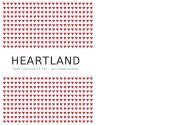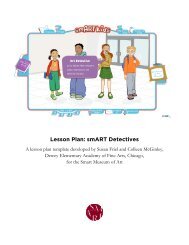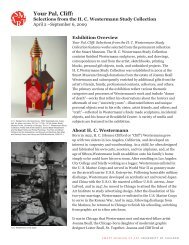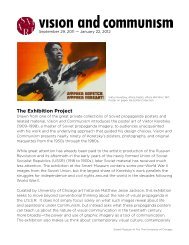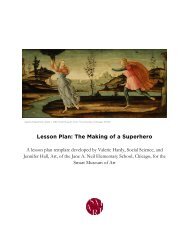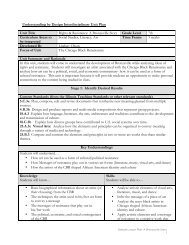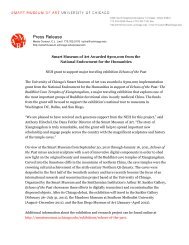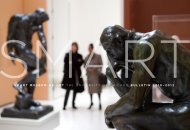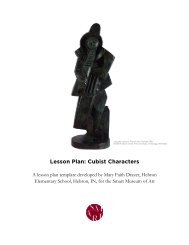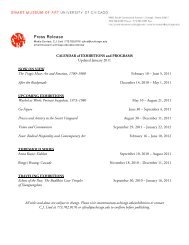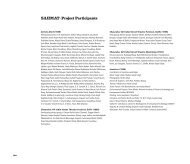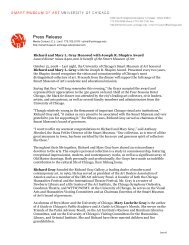Healthy Habits Teacher Resource - Smart Museum of Art
Healthy Habits Teacher Resource - Smart Museum of Art
Healthy Habits Teacher Resource - Smart Museum of Art
Create successful ePaper yourself
Turn your PDF publications into a flip-book with our unique Google optimized e-Paper software.
1<br />
<strong>Healthy</strong> <strong>Habits</strong> <strong>Teacher</strong> <strong>Resource</strong><br />
COMPONENTS in this resource:<br />
1) Sixth grade science lesson designed by: Valerie Hardy -‐ Jane A. Neil School<br />
2) Visual <strong>Art</strong>s lesson plan designed by: Lisa Davis, <strong>Smart</strong> <strong>Museum</strong> <strong>of</strong> <strong>Art</strong><br />
3) Health and Hospitality, museum tour design by: Lisa Davis, <strong>Smart</strong> <strong>Museum</strong> <strong>of</strong> <strong>Art</strong><br />
Social Science-‐<br />
The student integrates graphical information(e.g. pictures, videos, maps, time lines) with other information in a<br />
print or digital text.<br />
Science-‐<br />
Integrate quantitative or technical information expressed in words in a text with a version <strong>of</strong> that information<br />
expressed visually (e.g., in a flowchart, diagram, model, graph, or table).<br />
Reading Standard for Informational Text-‐<br />
determine the meaning <strong>of</strong> words and phrases as they are used in a text,<br />
including figurative, connotative, and technical meanings<br />
Writing<br />
Write informative/explanatory text to examine a topic and convey ideas, concepts, and information through<br />
the selection, organization, and analysis <strong>of</strong> relevant content.<br />
Research to Build and Present Knowledge<br />
Conduct short research projects to answer a question ( including self-‐ generated question),drawing on several<br />
sources and generating additional related, focused questions that allow for multiple avenues <strong>of</strong> exploration<br />
11:30-‐12:30 Science 6th Grade<br />
Monday Tuesday Wednesday Thursday Friday<br />
Science Science Science Science Science<br />
Strategy/ Skill<br />
Overview<br />
Students study Still-‐<br />
Life <strong>Art</strong>work and<br />
research symbolism<br />
pertaining to food<br />
choices.<br />
• Observe<br />
• Ask<br />
questions<br />
• Describe<br />
Vocabulary<br />
Balance, Caption<br />
Health, inanimate,<br />
natural, man-‐ made<br />
Moderate<br />
Still-‐Life<br />
Other vocabulary<br />
words may develop.<br />
Student Activity<br />
Students will<br />
examine several<br />
Strategy/ Skill<br />
Use Information to<br />
create<br />
Student Activity:<br />
Determine the<br />
meaning <strong>of</strong> the<br />
vocabulary as a<br />
group -‐ 8<br />
collaboration<br />
Next students will<br />
be creating their<br />
own work <strong>of</strong> art<br />
using prior<br />
knowledge and<br />
their own resources<br />
from home.<br />
(All examples are<br />
acceptable)<br />
Students will write<br />
informative<br />
Strategy/ Skill<br />
Identify a theme<br />
for further study<br />
Examine other<br />
sources <strong>of</strong> art<br />
Student Activity<br />
<strong>Teacher</strong>s dialogue/<br />
Question-‐<br />
In my examination<br />
<strong>of</strong> your Still-‐Life<br />
creation what idea<br />
or concept kept<br />
appearing. (types<br />
<strong>of</strong> food)<br />
<strong>Teacher</strong>-‐ I will<br />
show you a picture<br />
<strong>of</strong> a Still Life.<br />
Let's reflex back on<br />
our theme-‐Types<br />
<strong>of</strong> food.<br />
Strategy/ Skill<br />
Interpret<br />
information<br />
presented in<br />
diverse media<br />
Student Activity<br />
<strong>Teacher</strong>-‐ Before<br />
trip review<br />
objectives,<br />
students will take<br />
notes.<br />
Let the students<br />
know that we will<br />
discuss what The<br />
Balanced Plate is<br />
on Friday, but if<br />
they are curious<br />
go provide them<br />
with the website<br />
under<br />
Wednesday's<br />
Strategy/ Skill<br />
Comparing the past<br />
food choices, with<br />
Student Activity<br />
Students will compare<br />
the food choices<br />
found in the Still-‐Life<br />
painting from the<br />
<strong>Museum</strong> to a. their<br />
food preference (Mc<br />
Donald)<br />
And<br />
b. the new food policy<br />
from the Government<br />
( The Balance <strong>of</strong> Good<br />
Health)<br />
The teacher will also<br />
discuss possible<br />
preparation methods<br />
then and now(fast<br />
food).
artifacts around the<br />
classroom.<br />
Students will be told<br />
that these object<br />
could be considered<br />
Still-‐Life.<br />
We will discuss the<br />
meaning <strong>of</strong> a Still-‐<br />
Life(is a work <strong>of</strong> art<br />
depicting mostly<br />
inanimate subject<br />
matter, typically<br />
commonplace<br />
objects which may<br />
be either natural<br />
(food, flowers,<br />
plants, rocks, or<br />
shells) or man-‐made<br />
(drinking glasses,<br />
books, vases,<br />
jewelry, coins, pipes<br />
so on..)<br />
Questions Asked:<br />
Now that we know<br />
they are samples <strong>of</strong><br />
Still-‐Life what make<br />
these pieces <strong>of</strong> art<br />
different?<br />
Note-‐ vocabulary<br />
terms can be used<br />
to aid in students<br />
recognition <strong>of</strong> the<br />
words.<br />
What do you think is<br />
the purpose <strong>of</strong><br />
these Still-‐ Life?(why<br />
created)?inferring<br />
Later I will request<br />
students to find<br />
other examples in<br />
the classroom.<br />
( Please note the<br />
classroom has<br />
vases, baskets and<br />
bowls with items<br />
inside representing<br />
each season)<br />
paragraphs <strong>of</strong> their<br />
interpretation <strong>of</strong><br />
their art work,<br />
giving their purpose<br />
for this artistic<br />
piece.<br />
2<br />
Student examine<br />
pieces <strong>of</strong> art from<br />
The <strong>Smart</strong><br />
<strong>Museum</strong>.( art<br />
photos in picture<br />
frames, plastic and<br />
sleeves for easy<br />
viewing).<br />
All art is labeled.<br />
Is there a story in<br />
these work <strong>of</strong> art?<br />
Let students<br />
elaborate orally.<br />
If you see a story ,<br />
who or what do<br />
you think is the<br />
most important<br />
figure, shape or<br />
object?<br />
What type <strong>of</strong> foods<br />
do you see in the<br />
Still-‐Life?<br />
<strong>Teacher</strong>-‐Remind<br />
them that the art<br />
samples are from<br />
different periods <strong>of</strong><br />
time<br />
Does the food vary<br />
due to time<br />
period?<br />
What make you<br />
think this?<br />
Allow them to<br />
collaborate among<br />
themselves, too<br />
improve their<br />
written or oral<br />
answers.<br />
Place notes from<br />
the students<br />
responses on the<br />
board.<br />
The teacher said:<br />
Homework<br />
Students will<br />
present their<br />
reports the<br />
following Monday.<br />
<strong>Teacher</strong>-‐ Remember<br />
your presentations<br />
are due Monday!<br />
Show how creative<br />
you can be.<br />
Reread the letter you<br />
received from the<br />
NIB.
3<br />
Our class has just<br />
receive a letter<br />
from the NIB<br />
(Nutritional<br />
Investigation<br />
Bureau)<br />
<strong>Teacher</strong> -‐read<br />
letter orally while<br />
student follow<br />
along . Surprise it<br />
is all arranged we<br />
leave Thursday for<br />
The <strong>Smart</strong><br />
<strong>Museum</strong>. Let us<br />
review our task<br />
and form 5 teams.<br />
Teams are created<br />
and they are given<br />
time to discuss<br />
how they plans to<br />
accomplish the<br />
three task.<br />
Science Homework :<br />
Monday-‐ Bring objects to class to form your own/group Still-‐ Life<br />
Define Vocabulary word and discuss the next day.<br />
(If the teacher wishes to do so, they may brings objects in the class to help with the construction <strong>of</strong> the Still-‐<br />
Life).<br />
Tuesday-‐ Student given <strong>Smart</strong> <strong>Museum</strong> website to examine works <strong>of</strong> art<br />
To View:<br />
1. Go to this website-‐http://smartmuseum.uchicago.edu/<br />
2. Locate and press on the word Collection<br />
3. Insert the word Still-‐Life in search box<br />
4. Look the bottom and view the first set <strong>of</strong> drawing, then look press 2 for second set <strong>of</strong> artwork<br />
Wednesday-‐ Examine A Balance Plate for Health website to see how to construct their plate-‐<br />
http://www.planet-‐health.org/pdf/Five_food_groups.pdf<br />
Review letter from the NIB<br />
Thursday-‐ trip day to the <strong>Smart</strong> <strong>Museum</strong> for follow-‐up .yeah<br />
Friday-‐ team completes project for presentation on Monday<br />
Educational Support Staff Responsibilities-‐ circulating to help student stay on task<br />
Extension <strong>Resource</strong>s:<br />
Are You Pealing? by Saxton Freymann and Joost Elffers-‐ show vegetables with feelings<br />
Fun With Foods A Recipe For Math +Science -‐ AIMS Activities Grade 5-‐9<br />
Eat Right American Dietetic Association-‐ pamphlets<br />
Illinois Department <strong>of</strong> Human Services-‐ pamphlets<br />
Super Size Me -‐ CD on the effect <strong>of</strong> fast food
4<br />
U.S. Department <strong>of</strong> Agriculture-‐ Agricultural Research-‐ magazine with the details <strong>of</strong> new techniques in food<br />
development<br />
Renaissance artist Giuseppe Arcimboldo-‐ uses food to create a mosaic image<br />
Websites<br />
A Balanced Plate for Health<br />
www.planet-‐health.org/pdf/Five_food_groups.pdf -‐ Similar to A Balanced Plate for Health<br />
From J. Carter, J. Wiecha, K. Peterson, S. Nobrega, and S. Gortmaker, 2007, Planet Health, 2nd ed. (Champaign,<br />
IL: Human Kinetics). A Balanced Plate for<br />
Food a fact <strong>of</strong> life -‐ Food a fact <strong>of</strong> life<br />
www.foodafact<strong>of</strong>life.org.uk/section.aspx?siteid=3§ionid=37 -‐ Similar to Food a fact <strong>of</strong> life -‐ Food a fact <strong>of</strong> life<br />
Activities. IMAGE balanced plate activity. Make a balanced plate! Can you match the food to the groups?<br />
IMAGE lunchbox activity ·∙ Make a healthy lunchbox! ... Interactive
y Valerie Hardy<br />
5<br />
Good Morning Room 130, Your Mission, if you decide to take it is-‐<br />
The Department <strong>of</strong> Health and Welfare has chosen your classroom to investigate the following questions:<br />
1. What types <strong>of</strong> food choices were made throughout history?<br />
2. What was the food choices based on during the time period?<br />
3. Did these food choices effect the health or appearance <strong>of</strong> the parties involved?<br />
4. What is our current approach to making healthy food choices?<br />
In ordered to accomplished this assignment you will be given a trip to The <strong>Smart</strong> <strong>Museum</strong>, there you will<br />
observe Still-‐ Life paintings , artifact showing various foods and dining styles at different time periods.<br />
Your teams will find example <strong>of</strong> books, articles and websites about food choices. Finally you and your team will<br />
compile a presentation which will be composed <strong>of</strong> :<br />
1. original drawings <strong>of</strong> Still-‐ Life painting <strong>of</strong> foods with captions<br />
2. two individual reports on Still-‐Life painting from The <strong>Smart</strong> <strong>Museum</strong> , with captions on what you think they<br />
tell us about the time, people and the food available<br />
3. construction <strong>of</strong> a Balanced Plate, with foods in correct proportions, using the new guide lines.<br />
If you or your classmates fail in this mission The Department <strong>of</strong> Health will disavow any connection with you<br />
or your team. We have instructed Ms. Hardy to issue citations according to completed and accurate tasks.<br />
Go Luck !<br />
MISSION POSSIBLE<br />
This paper must will be taken away from you in one class period. This will give you time to discuss the<br />
assignment, plan, and designate jobs in your groups.
<strong>Teacher</strong> Name: Lisa Davis<br />
Class: Science<br />
Grade: sixth<br />
Lesson Title: The Science <strong>of</strong> Observation<br />
Start Date:<br />
Time Needed: 30 minutes-‐ one hour<br />
Objectives:<br />
1. Students will build observational skills<br />
6<br />
Visual <strong>Art</strong>s Lesson Plan<br />
2. Students will create (3) sketches <strong>of</strong> a still-‐life based on observation<br />
3. Students will discuss healthy and unhealthy food choices<br />
4. Students will create their own healthy food still-‐life collage from their initial sketches<br />
Materials Needed:<br />
Still-‐life reproduction image (poster or projected), still-‐life objects ( including food from the four food<br />
groups, “unhealthy” food choices, utensils, place settings <strong>of</strong> any material), pencils, erasers, paper,<br />
scissors, glue sticks. Each student gets four sheets <strong>of</strong> paper: three for initial sketches and one for the<br />
final piece. Their names should be on each piece before they begin the project.<br />
Standards Addressed:<br />
Check each strand <strong>of</strong> the scope and sequence addressed in this lesson:<br />
X <strong>Art</strong> Making X <strong>Art</strong>s Literacy X Evaluation/Interpretation X Making Connections<br />
Prepare in Advance:<br />
Complete other lessons in this unit as preparation. Set up a still life at each table group (or where each<br />
student can see one still-‐life). Sharpen pencils.<br />
Warm Up Activities:<br />
1) 5-‐10 minutes: Students should practice observing, spending one full minute looking at a poster<br />
or projected image <strong>of</strong> a still-‐life. Next cover that image (or remove it) and see how many details<br />
they can recall; this can be done verbally or as a written exercise. If you have time, this activity<br />
can be done again with a different image.<br />
2) 5 minutes: Students should practice sketching by making marks on a blank page. They can<br />
explore various ways to use their pencil (tip, side for shading, etc) to make marks. Sketching<br />
should be defined as initial observations and mark making not intended to be a final artwork.
7<br />
Main Activity:<br />
1) Students will complete three sketches, on three different sheets <strong>of</strong> paper, based on observation.<br />
The objective is to increase observation skills through noticing details and including those details<br />
in their sketches. Students should be given 5 minutes for each sketch. After the first sketch,<br />
students should change seats to get a different perspective <strong>of</strong> the same still-‐life. The students<br />
should change perspectives again after the second sketch. This will give them three sketches<br />
from various perspectives.<br />
2) In their table groups, students should decide which objects in their still-‐life are healthy choices<br />
and which are unhealthy. They can remove (give back to the teacher) those objects which are<br />
unhealthy.<br />
3) The final piece will be a collage still-‐life using their initial sketches, but with only the healthy<br />
choices included (the objects remaining on their tables can help remind them which should be<br />
included in the finished product). Collage is defined as a completed image assembled from<br />
other images. The word comes from the French word “coller”, to glue. Students can cut objects<br />
out <strong>of</strong> their sketches to put together on the fourth piece <strong>of</strong> paper. If you have time, students can<br />
add details using colored pencils.<br />
Wrap Up/Cool Down:<br />
<strong>Teacher</strong>s can repeat the warm-‐up activity with different images. Have student write down the details<br />
they recall before sharing as a group. Students can also do a turn and talk with others to explain their<br />
artwork and why they chose to include certain objects.<br />
Assessment Strategy:<br />
1) Using the written list <strong>of</strong> details from the wrap-‐up activity, teachers can determine if students<br />
increased their observational skills.<br />
2) <strong>Teacher</strong>s can collect the (3) sketches <strong>of</strong> a still-‐life based on observation to determine if this<br />
objective was satisfied.<br />
3) Using the artwork itself the teacher can determine if students were able to identify and include<br />
only the healthy food choices.<br />
4) <strong>Teacher</strong>s can collect students’ collages made from their initial sketches to determine if this<br />
objective was satisfied.<br />
<strong>Teacher</strong> Reflections:
<strong>Smart</strong> <strong>Museum</strong> <strong>of</strong> <strong>Art</strong><br />
Health and Hospitality: Lessons Learned Around the Table<br />
8<br />
Theme:<br />
Themes <strong>of</strong> health and hospitality have been explored by artists in various ways throughout history, from<br />
traditional still-‐life representations to contemporary artists considering the meal itself as an artistic medium. The<br />
current exhibition, for instance, Feast addresses the art <strong>of</strong> the experience <strong>of</strong> the shared meal.<br />
Tour Objective:<br />
Today we will be exploring artists’ representations <strong>of</strong> health and hospitality, taking time to look a still-‐life works<br />
to objects across cultures that represent the act <strong>of</strong> serving and the ritual and ceremony <strong>of</strong> eating together. Today<br />
we will observe artworks, describe details, and ask questions to discover the answer to the following questions:<br />
1. What types <strong>of</strong> food choices were made throughout history?<br />
2. What are the food choices based on during the time period?<br />
3. Did these food choices affect the health or appearance <strong>of</strong> the parties involved?<br />
4. What is our current approach to making healthy food choices?<br />
<strong>Art</strong>works to see today that relate to this theme:<br />
*in-‐storage, arrange in advance for Study Room display<br />
1. Still-‐life with Fruit and Flowers on a Draped Ledge, Michiel Simons, 2007.137<br />
2. Bowl, Korean (12 th century), 1986.157<br />
3. Five Piece C<strong>of</strong>fee Set, Designer Unknown, 2003.75b<br />
4. Dining Table and Six Chairs, Frank Lloyd Wright, 1967.73-‐79<br />
5. *Still-‐Life with Man, 1979.25 AND<br />
6. *Still-‐life with Woman, Justus Juncker, 1979.26<br />
7. *Still Life No. 1, Martha Erlebacher, 1978.167<br />
8. *Untitled (breakfast, smoked fish), Laura Letinsky, 2001.40<br />
9. *Guests at a Table, Otto Gleichman, 1998.80



